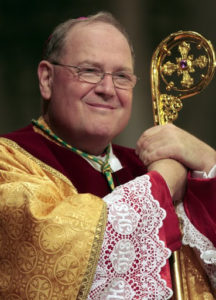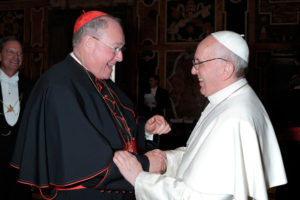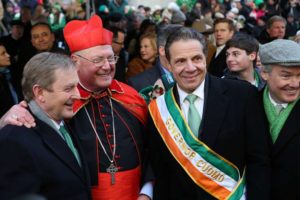 REUNIÓN DE CARDENAL CATÓLICO DE ESTADOS UNIDOS EN CUBA CON SU PRESIDENTE DIAZ-CANEL.
REUNIÓN DE CARDENAL CATÓLICO DE ESTADOS UNIDOS EN CUBA CON SU PRESIDENTE DIAZ-CANEL.
El cardenal de Nueva York Timothy M. Dolan se reunirá con el presidente de la República de Cuba durante un viaje del 7 al 12 de febrero a la isla, que incluye una visita al cardenal de La Habana y otros prelados cubanos.
El cardenal Dolan voló a La Habana a principios del 7 de febrero con una pequeña delegación del área de Nueva York y está programado para celebrar la misa en el Santuario de Nuestra Señora de la Caridad de El Cobre, la patrona de Cuba, durante la visita.
El cardenal Dolan se reunió con el presidente cubano Miguel Mario Díaz-Canel Bermúdez en 2018, el año en que asumió el cargo de jefe de Cuba de Raúl Castro. Díaz-Canel, de 59 años, visitó Nueva York más tarde en el otoño y habló ante las Naciones Unidas. Luego se reunió con el cardenal Dolan en la Catedral de San Patricio de Nueva York durante esa visita y le regaló al prelado: una estatua de Nuestra Señora de la Caridad de El Cobre.
Granma, el periódico oficial del gobierno publicado por el Partido Comunista, publicó el 27 de septiembre de 2018 un artículo sobre la reunión, llamando al cardenal “carismático” y diciendo que Díaz-Canel enfatizó los lazos de “respeto y comunicación estable y fluida entre Iglesia Católica y el gobierno de Cuba “, durante esa visita.
Aunque Díaz-Canel es el presidente de Cuba, Raúl Castro es el primer secretario del Partido Comunista de Cuba, que es la posición más importante en el estado comunista. Sin embargo, se espera que Díaz-Canel lo suceda en 2021.
Después de la revolución cubana de 1959 dirigida por el hermano de Raúl Castro, Fidel, el gobierno cubano, que se declaró oficialmente ateo, confiscó propiedades que habían servido como centros sociales, educativos y comunitarios de la vida católica, y una tensión de décadas entre el gobierno y el gobierno. Iglesia católica se produjo. El número de sacerdotes católicos y otros religiosos que servían en Cuba se redujo y, como los laicos, disminuyó enormemente con los años.
La Iglesia Católica de Cuba, sin embargo, experimentó una lentitud en las restricciones gubernamentales después de la visita de 1998 de San Juan Pablo II y el Papa Benedicto XVI en 2012, seguido por el Papa Francisco en 2015.
El Vaticano, con la ayuda del cardenal cubano Jaime Ortega de La Habana, quien murió en julio de 2019, desempeñó un papel importante en el acercamiento entre los gobiernos de Cuba y los Estados Unidos, y los dos países anunciaron el restablecimiento de las relaciones a fines de 2014, que incluyó la reapertura de sus respectivas embajadas en La Habana y Washington. Sin embargo, la administración Trump anunció sanciones y una reversión de algunas de las políticas realizadas durante ese tiempo.
La Iglesia Católica ha sostenido constantemente que es mejor comprometer a Cuba en lugar de aislarla, y los esfuerzos, desde el Vaticano hasta los obispos de Estados Unidos, han enfatizado las soluciones diplomáticas.
La visita del cardenal Dolan se produce tres días después de que el presidente Donald Trump reiteró en su discurso sobre el estado de la Unión que su administración “revirtió las políticas fallidas de la administración anterior sobre Cuba”.
 UNITED STATES CATHOLIC CARDINAL MEETING IN CUBA WITH PRESIDENT DIAZ-CANEL.
UNITED STATES CATHOLIC CARDINAL MEETING IN CUBA WITH PRESIDENT DIAZ-CANEL.
New York Cardinal Timothy M. Dolan is set to meet with the president of the Republic of Cuba during a Feb. 7-12 trip to the island nation, which includes a visit with the cardinal of Havana and other Cuban prelates.
Cardinal Dolan flew to Havana early Feb. 7 with a small delegation from the New York area and is scheduled to celebrate Mass at the Sanctuary of Our Lady of Charity of El Cobre, the patroness of Cuba, during the visit.
Cardinal Dolan met Cuban President Miguel Mario Diaz-Canel Bermudez in 2018, the year he took over as head of Cuba from Raul Castro. Diaz-Canel, 59, visited New York later in the fall and spoke before the United Nations. He then met with Cardinal Dolan at New York’s St. Patrick’s Cathedral during that visit and gave the prelate a present: a statue of Our Lady of Charity of El Cobre.
Granma, the official government newspaper published by the Communist Party, published Sept. 27, 2018, an article about the meeting, calling the cardinal “charismatic” and saying that Diaz-Canel emphasized the bonds of “respect and stable and fluid communication between the Catholic Church and the government of Cuba,” during that visit.
Though Diaz-Canel is the president of Cuba, Raul Castro is the first secretary of the Communist Party of Cuba, which is the most senior position in the communist state. Diaz-Canel, however, is expected to succeed him in 2021.
Following the 1959 Cuban revolution led by Raul Castro’s brother Fidel, the Cuban government, which declared itself officially atheistic, seized properties that had served as the social, educational and community centers of Catholic life, and a decades-long tension between the government and the Catholic Church ensued. The number of Catholic priests and other religious serving in Cuba became limited and, like the laity, greatly dwindled with the years.
Cuba’s Catholic Church, however, saw slow ease of government restrictions following the 1998 visit of St. John Paul II and Pope Benedict XVI in 2012, followed by Pope Francis in 2015.
The Vatican, with the help of Cuban Cardinal Jaime Ortega of Havana, who died in July 2019, played a major role in the rapprochement between the governments of Cuba and the U.S., and the two countries announced the reestablishment of relations in late 2014, which included the reopening of their respective embassies in Havana and Washington. The Trump administration, however, announced sanctions and a rollback of some of the policies made during that time.
The Catholic Church has constantly held that it’s better to engage Cuba instead of isolating it, and efforts — from the Vatican to the U.S. bishops — have emphasized diplomatic solutions.
Cardinal Dolan’s visit comes three days after President Donald Trump reiterated in his State of the Union address that his administration “reversed the failing policies of the previous administration on Cuba.”
Agencies/ Catholic News Service/ Rhina Guidos/ Internet Photos/ Arnoldo Varona/ www.TheCubanhistory.com
THE CUBAN HISTORY, HOLLYWOOD.









